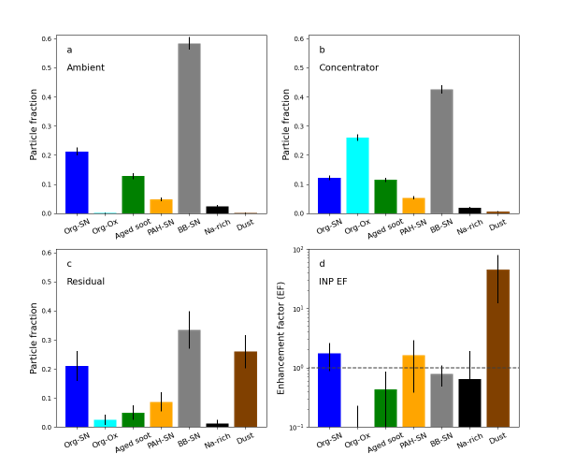Agricultural soils are efficient ice nucleating particles in the Southern Great Plains
Submitter
Burrows, Susannah M.
— Pacific Northwest National Laboratory
Area of Research
Cloud Processes
Journal Reference
Cornwell G, I Steinke, N Lata, A Zelenyuk, G Kulkarni, M Pekour, R Perkins, E Levin, S China, P DeMott, and S Burrows. 2024. "Enrichment of Phosphates, Lead, and Mixed Soil‐Organic Particles in INPs at the Southern Great Plains Site." Journal of Geophysical Research: Atmospheres, 129(13), e2024JD040826, 10.1029/2024JD040826.
Science

Figure 2. Particle type fractions for particles classified by the single-particle mass spectrometer (miniSPLAT) for (a) ambient,
(b) concentrator-enhanced, and (c) residual particles. Particle-type enhancement factors (EF) are shown in (d). Error bars show the uncertainty (5th–95th percentile). Figure from Cornwell et al. (2024)

Figure 1. Cloud droplets can freeze at warmer-than-typical temperatures if the right aerosol particle is present. Such particles are rare, but can affect the climate by changing the way clouds interact with solar radiation. Image by Peter Cassell|U.S. Food and Drug Administration (https://flic.kr/p/2iACMFe)
Ice nucleating particles (INPs) are a rare subset of particles that can have an outsized impact on weather and clouds by initiating the process of ice formation in clouds. Cloud ice plays an important role in the formation of precipitation as well as in changing the amount of sunlight clouds reflect to space and the amount of heat trapped by clouds. INP efficiency can vary widely by particle type, so it can be important to represent even rare particle types in atmospheric models, if they are strong INPs. Agricultural soils are hypothesized to be an important source of INPs on a regional scale due to their high ice nucleation efficiency and high emissions in areas with large agricultural activity. Researchers measured INP composition at the U.S. Department of Energy Atmospheric Radiation Measurement (ARM) user facility's Southern Great Plains (SGP) observatory near Billings, Oklahoma, by first nucleating INPs into ice crystals within a continuous flow diffusion chamber, then separating them inertially with a virtual impactor, and finally characterizing them using single-particle techniques. This methodology enabled the researchers to identify sources of INPs, along with the physicochemical properties that make these particles effective ice nucleators.
Impact
Understanding the sources of INPs is difficult due to the rarity of these particles, which makes characterizing them technically difficult. Many studies have used simple correlations between particle tracers and INP concentrations to understand important sources of INPs. However, this approach is limited because it neither proves that the particles are acting as INPs, nor does it provide insight into the physicochemical properties controlling ice nucleation. To overcome this weakness, this study used the technically challenging “residual method” to directly measure the composition of INP-32 at SGP. Researchers found that while ambient particles were made up primarily of carbon-containing materials, about a quarter of INPs were dust particles made up mostly of minerals—even though dust particles made up only 6% of the total particle population. Additionally, dust INPs were more likely to contain phosphates, a marker for agricultural soils, suggesting that these were likely windblown dusts from the surrounding agricultural areas. This study highlights the importance of agricultural soils to INP populations in agricultural regions such as the Great Plains. Future research should apply the residual method to better understand the sources and physicochemical properties of INPs in other regions.
Summary
INPs are a rare subset of atmospheric aerosol that can initiate ice formation in clouds. A significant gap separates scientists’ ability to measure INPs and to predict their concentrations and variability in large-scale weather and climate models. This is partly because of the wide variation in the ice nucleation efficiency of different particle types. As a result, even low-abundance particle types need to be represented in global climate models if their ice nucleation efficiency is high enough.
Understanding the sources of INPs in different regions is difficult, partly because their rarity makes it hard to observe and identify them directly in the atmosphere. Traditional methods of measuring aerosol composition can provide information on the size and composition of the overall particle population. INPs, however, can be as rare as one particle in one million, and they can have properties that are distinctly different from the majority of particles in the air. Because of this, it is challenging to determine the identities of INPs in field experiments when using traditional measurement methods. To address this challenge, researchers used the technically challenging “residual method” to directly measure INP composition at SGP. In this approach, individual INPs are separated from the total particle population, and their size and composition is measured with highly sensitive, specialized methods. Using this method, researchers observed that ambient particles were dominated by carbonaceous and secondary aerosol, while dust was the most efficient INP type. They also observed a novel mixed particle type consisting of a smooth carbonaceous core (like a tar ball) internally mixed with dust fragments. Dust INPs were enriched in phosphate, which is a good marker for agricultural soils, indicating that these windblown agricultural dusts may be an important source of INPs in the region. However, researchers were unable to distinguish whether this phosphate originated from natural microbial activity, or from the application of phosphate-containing fertilizers. Future research should investigate the ice nucleation efficiency of soils before and after fertilizer application to determine whether fertilizers may be partly responsible for the high ice nucleation efficiency of agricultural soils.
Keep up with the Atmospheric Observer
Updates on ARM news, events, and opportunities delivered to your inbox
ARM User Profile
ARM welcomes users from all institutions and nations. A free ARM user account is needed to access ARM data.


















